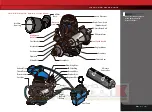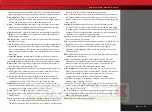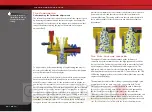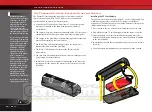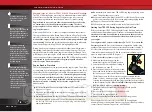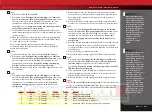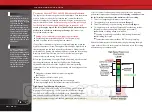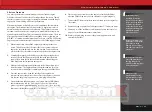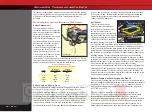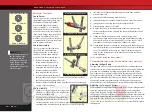
Revo • 31
The TRX 2.5R Racing Engine
Low-Speed Fuel Mixture Adjustment
The low-speed mixture is always set after the high-speed needle is
correctly adjusted. The low-speed mixture is set using the pinch test.
1.
Once the engine is warm, do several high-speed runs to confirm that
the high-speed needle is set correctly.
2.
Bring the vehicle in and pinch closed the fuel line going into the
carburetor (use the engine shut-off clamp). The engine should run
for 2-3 seconds, speed up, and then shut off.
3.
If the engine runs longer than 3 seconds, then lean the low-speed
needle 1/16 turn, make several more high-speed runs, and retest.
4.
If the engine shuts off immediately without speeding up, then richen
the low-speed needle 1/8 turn, make several more high-speed runs,
and retest.
When the low-speed needle is set correctly, the engine’s throttle
response should be very quick, possibly even to the point of making it
difficult to keep Revo from doing a wheelie when you accelerate!
Idle Speed Adjustment
Once the high and low-speed mixtures have been set, reduce the idle
speed to the minimum reliable idle speed. Remember, this adjustment
should be made while the engine is running at normal operating
temperature.
1.
Turn the throttle trim on the transmitter so that the brakes are
applied (note its original position). This ensures that the throttle slide
is resting against the idle adjustment screw.
2.
Turn the screw counterclockwise to reduce the idle speed, or
clockwise to increase it. The idle speed should be set as low as
possible while still maintaining reliable running characteristics.
3.
Reset the throttle trim on the transmitter to its original position.
Fine-Tuning the Carburetor
After fine-tuning your TRX 2.5R Racing Engine at the end of the break-in
procedure, no major adjustments to the fuel mixture are usually
necessary. Make note of the temperature, humidity, and barometric
pressure at the time you finished fine tuning your carburetor. Current
weather conditions can be found online from national websites, local TV
news websites, and television. This information will be considered your
baseline setting.
You may need to adjust your carburetor needles to compensate for
changes in temperature and barometric pressure (air density) from day
to day. Generally, you’ll need to richen the fuel mixture when the
weather is colder than your baseline temperature and the air density is
higher. Lean the fuel mixture when weather is warmer than your
baseline temperature and the air density is lower. The chart below
provides general guidelines on how weather conditions affect air density
when they move higher or lower than your baseline setting (see page 24
for detailed info on how air density affects mixture settings).
If the...
Humidity
Pressure (barometer)
Temperature
Altitude
Nitro %
is..
Lower
Higher
Lower
Higher
Lower
Higher
Lower
Higher
Lower
Higher
then the
air density is...
Slightly more dense
Slightly less dense
Less dense
More dense
More dense
Less dense
More dense
Less dense
adjust (correct)
the fuel mixture to be...
Slightly richer
Slightly leaner
Leaner
Richer
Richer
Leaner
Richer
Leaner
Leaner
Richer
When adjusting the low
speed fuel mixture, it is very
important to make several
high-speed runs with Revo
between adjustments to
clear out any excess fuel.
Perform the pinch test
immediately after. If the
engine is allowed to idle for
a long period of time, it
could “load up” with fuel
and give you an inaccurate
measurement from your
pinch test.



